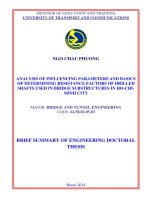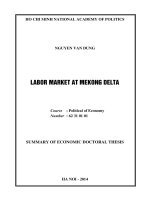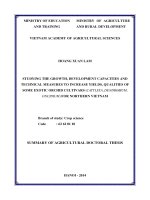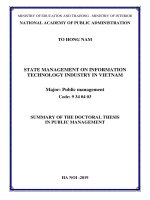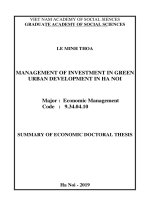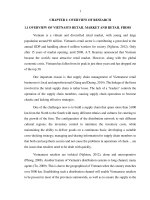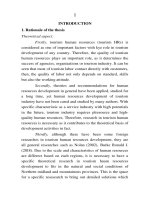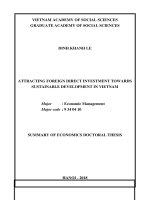Summary of Engineering Doctoral thesis: Lung flukes, paragonimus heterotremus and paragonimus westermani, in Vietnam: morphology, genetics, biology and immunology diagnosis
Bạn đang xem bản rút gọn của tài liệu. Xem và tải ngay bản đầy đủ của tài liệu tại đây (739.13 KB, 27 trang )
1
MINISTRY OF EDUCATION
VIETNAM ACADEMY OF SCIENCE
AND TRAINING
AND TECHNOLOGY
GRADUATE UNIVERSITY OF SCIENCE AND TECHNOLOGY
LUU ANH TU
LUNG FLUKES, PARAGONIMUS HETEROTREMUS AND
PARAGONIMUS WESTERMANI, IN VIETNAM:
MORPHOLOGY, GENETICS, BIOLOGY AND
IMMUNOLOGY DIAGNOSIS
Major: Parasitology
Code: 62.42.01.05
SUMMARY OF DOCTORAL THESIS
Hanoi, 2018
2
The thesis is completed at: Graduate University of Science and
Technology - Vietnam Academy of Science and Technology
Supervisors: 1. TS. Pham Ngoc Doanh
2. TS. Bui Khanh Linh
Reviewer 1:
Reviewer 2:
Reviewer 3:
The doctoral thesis will be defended at the Evaluation Committee of
Graduate University of Science and Technology, Vietnam Academy
of Science and Technology.
Time: Date…. month …. 2018
This thesis can be found at:
- The library of Graduate University of Science and Technology;
- National Library of Vietnam
3
INTRODUCTION
1. The necessity of the research
Lung flukes of the genus Paragonimus cause paragonimiasis
which affect human and animal health. The main reason of infection
is due to ingestion of metacercariae from second intermediate host or
juvenile flukes from paratenic host. Symptoms of lung fluke are
more likely to be misdiagnosed with pulmonary tuberculosis or other
pulmonary disease, producing difficulties to diagnose and treat the
disease (Blair et al., 1999).
In Vietnam, Paragonimus and paragonimiasis have been studied
for more than 20 years (Vien et al., 1994; De et al., 1998-2003;
Doanh et al., 2005-2013). To date, 7 Paragonimus species have been
reported (Doanh et al., 2013). Of which, P. heterotremus is prevalent
in the north provinces and P. westermani is prevalent in the north
central provinces. Both species can infect humans. However, many
issues of two species have not been unknown. Therefore, we
conducted a study on “Lung flukes, Paragonimus heterotremus and
Paragonimus westermani, in Vietnam: morphology, molecular
biology and immunological diagnosis”
2. Objectives
The main purpose of this topic is to increase the knowledge of
two species, P. heterotremus and P. westermani, in order to provide
a scientific basis for diagnosis and prevention of paragonimiasis,
contribute to public health protection.
The specific objects:
1. To determine the best method for detection of Paragonimus
metacercariae in crabs and to determine the status of
Paragonimus metacercariae infection in crabs in Lao Cai, Yen
Bai and Quang Tri provinces.
2. To determine the morphological diversity of metacercariae and
molecular diversity of P. heterotremus and P. westermani.
4
3. To identify the biological characteristics of P. heterotremus and
P. westermani.
4. To set up dot-ELISA to rapidly diagnose paragonimiasis in the
field.
3. Research contents
3.1.
Determination of the best method of crab examination for
Paragonimus metacercariae and investigation of metacercarial
infection in crabs in Lao Cai, Yen Bai, Quang Tri.
3.2.
Study of the morphological diversity of metacercariae and
molecular variation of P. heterotremus and P. westermani.
3.3. Identification of the biological characteristics of two species
- Identification of the first intermediate host and definitive hosts.
- Development of lung fluke in the definitive and paratenic hosts
- Observation of the vitality of metacercariae.
3.4. Set up dot-ELISA to diagnose paragonimiasis.
- Determination of the specificity and sensitivity of dot-ELISA
- Determination of antigen concentration of the reaction.
- Determination of the reaction time at different temperature
conditions.
4. Scientific and practical meaning of the topic
4.1. Scientific meaning: This study provides the scientific
information on the morphology of metacercariae, genetics and
biological characteristics of P. heterotremus and P. westermani in
Vietnam.
4.2. Practical meaning: This study provide the scientific basis for
the prevention of Paragonimus infection and established dot-ELISA
for rapid diagnosis of paragonimiasis in the field, contributing to
public health protection.
5. New contributions of the topic
5.1. Detected metacercariae of P. heterotremus in the Central and
P. westermani in the North, and described the morpholigical
diversity of metacercariae of the two speices.
5
5.2. Analysed the genetic diversity of P. heterotremus and
P. westermani.
5.3. Identified the first intermediate hosts and cercaria larvae of two
species P. heterotremus and P. westermani, and also
P. proliferus.
5.4. Identified wild cats as the definitive host of Paragonimus spp. in
DaKrong district.
5.5. Identified that domestic dog were not infected with
P. westermani and domestic cat were infected with
P. westermani with susceptibility lower than that of
P. heterotremus.
5.6. Identified mice as paratenic host in life cycle of P. heterotremus
and P. westermani in Vietnam.
5.7. The vitality of metacercariae depends not only on the culture
medium and temperature, but also on the density of
metacercariae.
5.8. Established dot-ELISA and determined the reaction time in
different temperature conditions, which can be applied to rapidly
diagnose paragonimiasis in the field.
6. Thesis structure
The dissertation composed of 111 pages, including introduction 3
pages, 21 pages of literature review, 15 pages of materials, content and
methodology, 54 pages of results and discussion, 3 pages of conclusions
and suggestions, 2 pages of new contribution and publications, 13 page of
references. The thesis has 21 tables, 54 images and charts, 132 references.
CHAPTER 1. OVERVIEW
1.1. Lung flukes of the genus Paragonimus
To date, more than 50 lung fluke species of the genus
Paragonimus have been described. The life cycle of lung fluke
requires three to four hosts. The definitive hosts are wild and
domestic animals, especially cats and dogs, and also human being.
The first intermediate hosts are freshwater snails, and the second
6
intermediate hosts are crab and some freshwater shrimp species
(Blair et al., 1999). Paratenic hosts are some crab eaters.
Diagnostic methods for detection of paragonimiasis include four
groups: parasitology, serological/immunological, imaging and
molecular methods.
1.2. Paragonimus heterotremus and Paragonimus westermani
1.2.1. Paragonimus heterotremus
P. heterotremus is distributed in South Asia, Southeast Asia,
and Southern China, and causes human disease in these areas. The
first intermediate hosts are member of the family Assimineidae and
Pomatiopsidae. The second intermediate hosts are six crab species of
the family Potamidae. The natural definitive hosts are cats and
squirrels in Thailand, experimental animals are dogs, cats, mice and
rabbits. Mice act as paratenic hosts (Blair et al. 1999).
1.2.2. Paragonimus westermani
P. westermani is widely distributed in Asia, with a great diversity
of morphology, genetics, and biology. Paragonimus westermani has
two types of triploid (3n) and diploid (2n). Life cycle requires 3-4
host species. The first intermediate hosts are species of Brotia and
Semisulcospirus. The second intermediate hosts are 8 species of
shrimp and 40 species of crabs. The definitive hosts are many species
of mammals. The susceptibility to P. westermani varies markedly
among geographic populations. Remarkably, people infected with
P. westermani are limited to East Asia and the Philippines. The
paratenic hosts include pigs, wild pigs and deer (Blair et al., 1999;
Yoshida et al., 2016).
1.3. Research on Paragonimus and paragonimiasis in Vietnam
Paragonimiasis in Vietnam has been studied since 1994. So far,
seven species have been found in the northern and central provinces.
Of these, three species (P. heterotemus, P. westermani and
P. skrjabini) have the potential to infect humans. Paragonimus
skrjabini species was found in Thanh Hoa province with low
infection rate; P. heterotremus is prevalent in the North;
7
P. westermani species is prevalent in the Central (Doanh et al.,
2013). Many problems of P. heterotremus and P. westermani have
not been elucidated (Doanh et al., 2013). In addition, new cases of
paragonimiasis are still being discovered. Therefore, rapid and
simple diagnostic technique in the field is necessary to cure diseases
in a timely manner, contributing to the protection of public health.
These issues will be addressed in this thesis.
CHAPTER 2
MATERIALS AND METHODS
2.1. Materials and study locations
2.1.1. Materials
P. heterotremus and P. westermani.
2.1.2. Study locations
Luong Son commune (Bao Yen district, Lao Cai province) and
An Lac commune (Luc Yen district, Yen Bai province) where the
prevalence of P. heterotremus metacercariae is high and four
communes of Quang Tri province are Huong Son and Tan Thanh
(Huong Hoa district), and Da Krong and Ta Long communes (Da
Krong district) - where P. westermani infection in second
intermediate host is very high.
2.1.3. Study time: from 10/2014 to 10/2017
2.2. Approach and experimental design
Detection of metacercariae in second intermediate hosts is
fastest and is the most accurate indicator of the distribution of
Paragonimus. Therefore, at the study sites, crabs will be examined
first to identify the sites with the highest prevalence of metacercariae
of two species P. heterotremus and P. westermani for further
identification of the natural definitive and first intermediate hosts.
Combination of morphological and molecular methods to identify
both Paragonimus and their hosts. Metacercaria were collected for
other morphological, genetic and biological studies.
8
2.3. Methods
2.3.1. Methods of collecting metacercariae
Determination of sedimental time of refining method: Take a
crab caught from non-endemic area. Remove the crab shells, pestle
in a mortar.
Adding 50 P. westermani metacercariae in freshly grounded
crab and 250 ml of water, stir well and filter through a 1 x 1 mm
sieve into a 300 ml plastic cup. Stand for the test time, then pour ½
portion of the solution to another cup. Adding water to the residue.
Repeat procedure of filtering-sediment until the sediment is clear
and can be seen under a microscope. The tests will be done with
sedimentation time between filters of 3 minutes, 2 minutes and 1
minute by using the stopwatch. Experiments were repeated 3 times.
Examination of the last sediment under a microscope to find the
metacercariae.
The most appropriate sedimentation time is the shortest time to
recover 50 metacercariae in the sediment of the final filter. Do the
same procedure with the metacercariae of P. heterotremus.
Comparison of two methods of filtering-sediment and pressing
between two glasses regarding the time and the number of
metacercariae obtained.
2.3.2. Investigation of infection rates of metacercariae
Catching crabs at streams, at least 50 crabs for each sites.
Identification of crabs is according to Dang Ngoc Thanh and Ho
Thanh Hai, 2012.
Using the best method determined to examine the crabs for
the rate and intensity of infection.
2.3.3. Morphological study of metacercariae: Based on shape, size
and shell thickness. Metacercariae was morphologically identified
according to Doanh et al., 2013.
2.3.4. Molecular variation of lung fluke
9
Gene selection: for P. heterotremus, ITS2 and mitochondrial
CO1 gene were selected, for P. westermani ITS2 and 16S
mitochondrial gene were selected, as this gene can discriminate
between 2n/3n types of P. westermani.
Molecular analyses include following steps: Total DNA
extraction; PCR reaction to replicate target sequence with selective
primer; purification of PCR product; direct sequencing; comparison
of obtained sequences with available sequences in GenBank by
BLAST and phylogenetic tree were generated by MEGA6 software.
2.3.5. Infections to the hosts
Two species were experimentally infected for 10 white mice
with 50 metacercariae/mouse. After 1 to 2 months, the mice was
sacrified for juveline worms and transfer to cats.
P. westermani were infected to 4 dogs and 8 domestic cats with
30-50 metacercariae/host. Monitoring of laboratory animals, periodic
examination of faeces to find eggs by the sedimentaion method,
determine the time of development of flukes in animals.
2.3.6. The morphology study of mature fluke: Staining the specimen
by carmine alumine staining method. Measure the size of flukes and
organs (suckers, testicles and ovaries).
2.3.7. Identification of the natural host of the lung fluke
- Identification of first intermediate hosts: snail species were
collected at the sites with high infection rate in crab host, and were
identified according to Dang Ngoc Thanh et al., 2006. Sheding and
squeezing between two glasses were done to collect cercariae. The
cercariae were identified by analyzing ITS2 sequences. The snail
infected with Paragonimus larvae were re-identified by CO1
sequences.
- Identification of the definitive host: Examination of stool
samples of domestic dogs and wild animals for Paragonimus eggs.
Eggs will be identified by ITS2 sequences. Stool samples containing
10
Paragonimus eggs were used to identify the host by D-Loop region
of the mitochondrial genome.
2.3.8. Vitality of metacercariae
- Metacercariae of each species was cultured in physiological
solution, at different temperature conditions: room temperature and
40C at densities of 5, 50, 100, 200 metacercaria/1ml. Periodically
observe under a microscope to determine the excystation and
viability of the metacercariae.
2.3.9. Set up a dot-ELISA assay
- Antigen of P. heterotremus and P. westermani.
- 30 serum samples of paragonimiasis patients infection, 30
samples of patients infected with fascioliasis, clonorchiasis,
pulmonary tuberculosis and normal human serum were used to check
for cross-reactivity.
- Dot-ELISA technique were performed according to Ito and Sato
1990. Reactions at different concentrations of antigen, temperature,
and time to provide optimum conditions.
2.4. Statistic analysis: Excell, SPSS.
CHAPTER 3
RESULT AND DISCUSSION
3.1. Comparison of two methods of crab examination and
infection rates of metacercariae in crabs
3.1.1 Comparison of two methods of crab examination
3.1.1.1. Determination of sedimentation time of refining method.
With crab-filtering method, the time for sedimentation to the
bottom of P. westermani is 2 minutes, P. heterotremus is 3 minutes.
Metacercariae of P. heterotremus is smallest compared to other lung
fluke species (Doanh et al., 2015), so 3 minute is the most
appropriate time.
3.1.1.2. Comparison of two methods
11
The time to examine a crab by filtering method was 33-38
minutes (mean 35,5 minutes) which was faster than that of pressing
crab between two glasses (76-85, mean 80.3 minutes) (P <0.005).
Of the 10 crabs collected in Yen Bai, 902 metacercariae was
collected by filtering method, while pressing between two glasses
collected 252 metacercariae (P <0.001).
3.1.2. Infection rate and intensity of metacercaria in crabs
At the study sites, three species of crabs were found:
Indochinamon tannanti in Yen Bai and Lao Cai, and two species of
Vietopotamon aluoiense and Donopotamon haii in Quang Tri
province.
All 3 crab species were infected with Paragonimus
metacercariae. The incidence and intensity of infection is shown in
Table 3.4.
Table 3.4. Prevalence of metacercariae in crabs
Sites
Province
Lao Cai
Yen Bai
Quang
Tri
Commune
Crab
species
Number
District
Bao
Yen
Luc
Yen
Da
Krong
Luong Son
I. tannanti
70
Number
of
infection
(%)
58 (82,8)
An Lac
I. tannanti
130
91 (70,0)
Da Krong
V.
aluoiense
V.
aluoiense
V.
aluoiense
V.
aluoiense
50
39 (78,0)
50
48 (96,0)
50
50 (100,0)
50
5 (10,0)
12-608
(80,0)
8-500
(140,8)
1-6 (3,4)
D. haii
50
6 (12,0)
1-3 (2,2)
Ta Long
Huong
Hoa
Huong Son
Tan Thanh
Intensity
4-504
(63,8)
1-362
(19,7)
1-78 (10,1)
In Quang Tri, metacercariae of four species (P. westermani,
P. bangkokensis, P. proliferus and P. heterotremus) were found, of
which P. westermani infection was highest. In two communes (An
Lac and Luong Son) metacercariae of 4 species (P. heterotremus,
12
P. vietnamensis, P. westermani and P. bangkokensis) were found, of
which the infection rate of P. heterotremus was highest (table 3.5).
Table 3.5. Infection rates of Paragonimus species in crabs
Site
Luong
Son
An
Lac
Da
Krong
Ta
Long
Huong
Son
Tan
Thanh
Crab
species
I.
tannanti
I.
tannanti
V.
aluoiense
V.
aluoiense
V.
aluoiense
V.
aluoiense
Rate (%) and intensity of infection (metacercaria / crab) of species
P.
vietnamensis
P.
heterotremus
8,6
(1-4)
6,0
(1-2)
82,8
(4-504)
69,2
(1-360)
4,0
(1-2)
D. haii
P.
bangkokensis
P.
westermani
1,5
(2-2)
6,0
(1-2)
8,0
(1-4)
4,0
(1-3)
2,0
(1)
13,8
(1-33)
78,0
(1-78)
96,0
(12-608)
100,0
7-500
10,0
(1-5)
P.
proliferus
4,0
(1)
12,0
(1-3)
Note: The number in parentheses is the range of intensity
3.2. Metacercarial morphology and molecular genetics
3.2.1. Paragonimus westermani
Metacercariae of P. westermani collected from Yen Bai were
relatively uniform in morphology while those collected from Quang
Tri differed in their size and shape (P <0.001), and were divided into
five forms (Figure 3.5a-e).
Figure 3.5. P. westermani metacercaria collected from Quang Tri.
13
ITS2 sequences of P. westermani differed 1-2 (0.2-0.4%)
nucleotide positions, forming one group (Figure 3.6). The 16S
sequences of P. westermani collected from Quang Tri and Yen Bai
provinces varied by 1.1-1.4%, forming two groups in the same clade
(Figure 3.7). The P. westermani of Vietnam belong to 2n type.
3.2.2. Paragonimus heterotremus
Metacercariae of P. heterotremus collected from Yen Bai and Lao
Cai have a diversity of sizes (Figure 3.8). In Quang Tri, 2 metacercariae
were obtained with the oval shape, size 226-252 x 218-236 μm
Figure 3.8. Metacercaria of P.
heterotremus collected from Yen Bai
and Lao Cai
Molecular analyses revealed that ITS2 and CO1 sequences of
two samples of P. heterotremus from Quang Tri were completely
identical to each other and highly similar to samples from the North
(Figures 3.10 and 3.11).
14
Figure 3.6. Molecular evolution relationships of P.
westermani populations based on ITS2 sequences
were constructed using the Maximum Likelihood
method
Figure 3.7. The molecular evolution relationships of
P. westermani populations based on the 16S gene
sequences were constructed using the Maximum
Likelihood method.
15
Figure 3.10. The molecular evolution relationship of
P. heterotremus populations are based on the ITS2
sequence.
Figure 3.11. The molecular evolution relationship of
P. heterotremus populations are based on the CO1
sequence.
16
3.3.
Biological characteristic of Paragonimus heterotremus and
Paragonimus westermani
3.3.1. First intermediate hosts
Cercaria belonging to the microcercaria group were found in
small snails (4 mm) of subfamily Triculinae in Lao Cai, Yen Bai and
Huong Son (Quang Tri), and large snails (4 cm) like Sulcospira in
Quang Tri.
CO1 sequence analysis of the large snail specimens in Quang
Tri province identified them as Sulcospira quangtriensis. CO1
sequences of small snails had the highest similarity (90-91%) with
Gammatricula fujiansis (AF213342). Small snails in Yen Bai and
Lao Cai were similar to each other, but were different from the snail
in Quang Tri at 12.6%. The distance between species of
Gammatricula varied from 6.4% to 12.5%. Therefore, it can be
confirmed that small snails from Quang Tri are different from snails
collected from Yen Bai and Lao Cai. On the phylogenetic tree, they
formed different branches closed to genus Gammatricula and Tricula
of subfamily Triculinae with low bootrap values. Therefore, these
specimens should be placed in the Gammatricula genus or other of
the subfamily Triculinae. At present, we temporarily named the
snails species from Lao Cai and Yen Bai as Triculinae gen sp.1 and
from Quang Tri as Triculinae gen sp.2.
The ITS2 of larvae collected from Triculinae gen sp1. from
Lao Cai and Yen Bai was completely identical (100%) to
P. heterotremus, and that from snail Triculinae gen sp.2 was
P. proliferus, and that from snail S. quangtriensis was P. westermani.
Morphology of larvae in intermediate host
Cercaria of 3 species is very similar in shape and size (P>
0.05). Rediae of three species is similar in size ((P > 0.05). However,
they can be distinguished by the intestinal length and the number of
cercariae in each redia. The redia of P. westermani has a long
intestine equal to 70% of the body, the other two species have a short
17
intestine equal to 20% of the body length ((P <0,001). Redia of
P. heterotremus has 10-12 cercariae which is more than P. proliferus
containing 4-5 cercariae / redia (Figure 3.20).
Figure 3.20. Cercaria (upper)
and redia (lower) of
a. P. heterotremus;
b. P. proliferus;
c. P. westermani
Infection rate of Paragonimus larvae in snails
Snail Triculinae gen sp.1 in Lao Cai and Yen Bai were
infected with Paragonimus larvae at 1.0 and 0.3%, respectively.
In Huong Son district, Triculinae gen sp.2 has very low rate
of 0.02%, snails S. quangtriensis caught in large streams were not
infected with Paragonimus larvae, but snails in small streams were
infected with infection rate of 1.0%. Paragonimus cercariae was not
found from snail S. quangtriensis collected in Da Krong commune.
The first intermediate hosts of the three Paragonimus species
is summarized in Figure 3.21.
18
Figure 3.21. Snail intermediate host of Paragonimus species
a. Triculinae gen sp.1 as first intermediate host of P. heterotremus;
b. Triculinae gen sp.2 as first intermediate host of P. proliferus;
c.
Sulcospira
quangtriensis
as
first
intermediate
host
of
P. westermani
3.3.2. Natural definitive hosts of Paragonimus
30 feces samples of domestic dogs from 2 communes of Huong
Son and Da Krong were negative. Examination of 120 fece samples
of wild animals collected in Da Krong Nature Reserve found
Paragonimus eggs in 7 samples. ITS2 sequences identified them as
P. westermani (3 samples), P. heterotremus (2 samples) and
P. skrjabini (2 samples). The D-Loop sequences of the positive
samples for Paragonimus eggs were analyzed and identified all of
them as wildcat, Prionailurus bengalensis.
3.3.3. Development of Paragonimus in hosts
3.3.3.1. Development of P. westermani in hosts
Juvenile flukes were found in muscles and livers of all
experimental mice. The development rate were ranged from 25-75%.
19
Worms from muscles occupied 65.3% and those from the livers hold
34.7%. Juvenile worm from muscle and livers of mice are slightly
larger than metacercariae (Fig. 3.28).
The infection of domestic animals showed that P. westermani
does not develop in domestic dogs. In contrast, all cats are infected.
The majority of worms are immature, the percentage of adults is low.
Eggs were released 140 to 145 days post-infection (Table 3.14).
Table 3.14. Experimental infection of P. westermani in domestic
animals
Animals
Pathogens
Eggs
release
dpi
Surgery
dpi
Dog 1
Dog 2
Dog 3
Dog 4
Cat 1
Cat 2
Cat 3
Cat 4
Cat 5
Cat 6
Cat 7
50 mc
50 mc
50 mc
50 mc
50 mc
50 mc
50 mc
30 mc
50 mc
30 mc
47 immature
fluke
30 immature
fluke
145
140
-
Cat 8
Development
rate (%)
150
200
200
200
40
45
90
120
150
170
180
Number of fluke
obtained
Lung
Lung
cavity
0
0
0
0
0
0
0
0
17
0
18
0
8
0
4
0
2
20
12 (2*)
7
18 (5*)
5
100
13
43.3
0
0
0
0
0
34.0
36.0
16.0
13.3
44.0
54.3
48.9
* Number of mature fluke; mc: metacercariae; dpi: day post
infection
Morphological analyses revealed that spermatozoa filled with
sperm, confirming P. westermani in Vietnam as 2n type. This
consistent with the results of molecular analysis. The size of the
parasite from the lungs and lung cavity of the experimental cat was
large (Figure 3.28).
20
Figure 3.28 . The
development of P.
westermani in experimental
animals
a. New excysted
metacercaria; b. Flukes
collected from mouse
muscle after 30 days; c.
Adult fluke collected from
lungs of cat after 180 days;
d. Young fluke collected
from cat after 180 days.
3.3.3.2. Transient infection of P. heterotremus to host.
Surgery of white mice revealed that the worm in the muscle has
no development in comparison with newly excysted metacercariae
with the size of 650-940 x 300-480 μm. Juveniles from liver (2.2-4.5
x 1.2-2.4 mm) was larger than that from the muscle (Fig. 3.31).
Transient infection in two cats showed that cats fed with juvenile
worms from rat liver were not infected, whereas cats fed juvenile
worms from muscles was infected with the rate of growth to adult of
45%.
Figure 3.31. Different sizes of juvenile worms from muscle (a) and
liver (b) of mice
21
3.3.4. Vitality of metacercariae
At the room temperature, metacercariae can live up to 15-17
days, the number of metacercaria were excysted and died the most at
7-8 days, accounting for 32-33.3% (Figure 3.34).
Figure 3.34. Vitality of metacercaria at room temperature (25-30oC)
in physiological saline
At 4oC, with different metacercarial densities (5, 50, 100 and
200 metacercaria/2ml), the results showed that metacercariae could
live up to 12 months. At low metacercaria density (5 metacercaria/
2ml) the survival time was longer than the higher densities
(P <0.005). At a density of 200 metacercaria / 2ml, the rate of
excysted metacercaria and death was highest after 2 months and
lived for 7-8 months. At 50 and 100 metacercaria/2ml, the
metacercariae can live up to 10-11 months, with the highest rate of
death at 6-7 months (Figures 3.35 and 3.36). There was no difference
in vitality of the two species of P. westermani and P. heterotremus
(P> 0.05).
22
Figure 3.35. The vitality of P. westermani metacercaria at 4oC at
various densities
Figure 3.36. The vitality of P. heterotremus metacercaria at 4oC at
different densities
3.4. Set up a rapid dot-ELISA assay to diagnose
paragonimiasis
3.4.1. Specificity and sensitivity
The reaction works well. Control squares show very clear color.
The serum of patients infected with P. heterotremus showed very
dark color in square doted with P. heterotremus antigen and slightly
fainter in P. westermani antigen. The serum of normal samples,
patients of fascioliasis, clonorchiasis, tuberculosis were negative,
except for one serum sample of Fascioliasis patients, however, the
color was lighter than serum infected with P. heterotremus (Figure
3.38).
23
Figure 3.38. Results of dot-ELISA assay
The results showed that the sensitivity of the reaction was 100%,
the specificity of the reaction was 95%, the predictive value was
96.7% and the negative predictive value was 100% (Table 3.18). .
Table 3.18. Sensitivity and specificity of the dot-ELISA assay
Dot-ELISA
Serum
Number of
tested
sample
dot-ELISA result
Positive
Negative
Total
Fluke positive
30
30
0
30
Fluke negative
30
1
29
30
31
29
Total
Sensitivity (%)
30/(30 + 0) x 100 = 100
Specificity (%)
29/(29+ 1) x 100 = 96,7
Positive predictive value (%)
30/ (30 + 1) = 96,7
Negative predictive value (%)
29/(29 + 0) = 100
3.4.2. Antigen concentration
At 0.25 mg/ml antigen, the color were light and hard to detect.
In contrast, at concentrations of 1 mg/ml and 0.5 mg/ml the color
was clear. Concentration of 0.5 mg/ml showed slight fainter than that
24
of 1 mg/ml, but can be observed clearly. Thus, the antigen
concentration of 0.5 mg/ml can be used, reducing a half in
comparison to previous publications.
3.4.3. Reaction time in different temperature condition
The reaction time depends on the temperature (table 1.19). The
reaction time of the dot-ELISA assay in the field varied from 51
minutes at 37°C, equivalent to summer temperatures, to 3 hours 26
minutes at 10°C or 4 hours 21 minutes at 4°C, equivalent to winter
temperature.
A dot-ELISA can read the results with naked eyes, without a
spectrophotometer. This assay can be done in the field, even in cold
winter days at around 4°C. Patients can wait for the results and
receive medication during a day.
Table 3.19. Reaction time of ELISA assay at different temperatures
Temperature
Time incubation with
Serum Conjugate Wash Color
Total
development
37oC
20
20
6
5
51
(0h51’)
o
20 C
60
60
6
5
131
(2h11’)
o
10 C
90
90
6
10
206
(3h26’)
o
4C
120
120
6
15
261
(4h21’)
CONCLUSION
1. Method of crab examination and infection rate of
metacercariae in crab hosts
- With the refining method, the sedimental time between two
filters of 3 minutes is appropriate for collecting metacercariae.
25
The crab-filter method is easier to collect metacercaria and is
more accurate than the pressing method.
- Prevalence and intensity of infection in Luong Son commune
(Lao Cai) was 82.8% and 4-504 metacercariae/crab, in An Lac
(Yen Bai) 70.0% and 1-362 metacercariae/crab. In Quang Tri
province, the infection rate and intensity in Ta Long commune
was 96.0% and 12-608 metacercaria/crab; in Da Krong
commune, those data are 78.0% and 1-78 metacercaria/crab, in
Huong Son commune (100% and 7-500 metacercariae/crab), in
Tan Thanh commune (10.0% and 1-6 metacercariae/crab).
- Crabs in Lao Cai and Yen Bai were infected with 4
Paragonimus species and crabs in Quang Tri province were
also infected with 4 Paragonimus species. Among them, the
highest infection rate of P. heterotremus was in Lao Cai and
Yen Bai, while the highest infection rate of P. westermani was
in Quang Tri province.
2. Morphological and genetic diversity of P. heterotremus and
P. westermani
- Metacercariae of the two species showed variation in
morphology and size, but have a high similarity of genetics.
- Molecular analysis identified that P. westermani in Vietnam
belongs to 2n type.
3. Biological characteristics of Paragonimus heterotremus and
Paragonimus westermani
- The first intermediate host of P. heterotremus, P. westermani
and P. proliferus are snail Triculinae gen sp. 1, S. quangtriensis
and Triculinae gen sp.2, respectively.
- Cercariae of the three Paragonimus species is morphologically
similar but can be distinguished by the length of intestine and
number of cercaria per redia.
- The natural definitive hosts of P. westermani are wildcats
(Prionailurus bengalensis). Wild cats in Da Krong are infected
